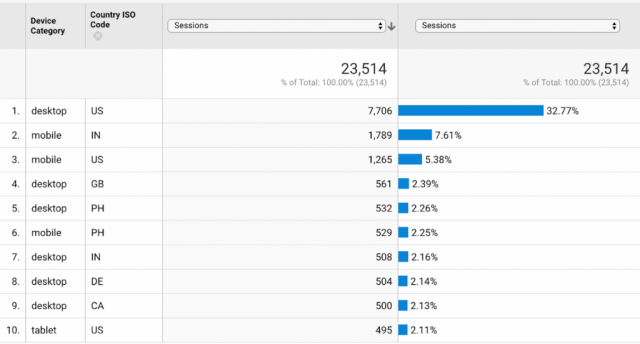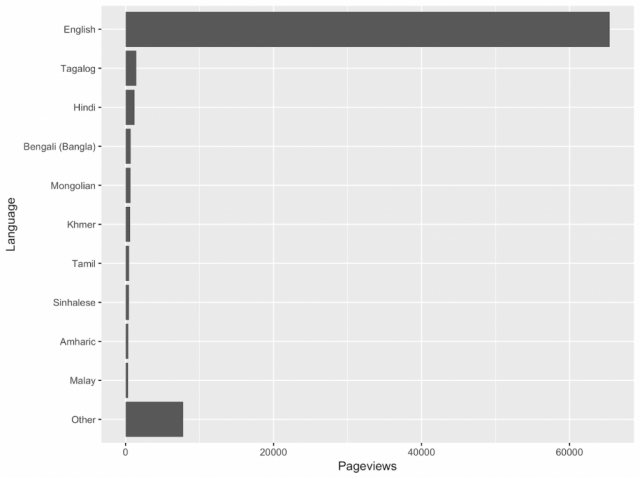This is the third post in a three part series about the Open Review of Bit by Bit: Social Research in the Digital Age. This post describes how Open Review led to increased access to knowledge. In particular, I’ll provide information about the general readership patterns, and I’ll specifically focus on readership of the versions of the manuscript that were machine translated into more than 100 languages. The other posts in this series describe how Open Review led to a better book and higher sales.
Readership
During the Open Review period, people from all over the world were able to read Bit by Bit before it was even published. The map at the top of the page shows the locations of readers around the world.
In total, we had 23,514 sessions and 79,426 page views from 15,650 users. Also, unlike annotations, which decreased over time, there was a relatively constant level of traffic, averaging about 500 sessions per week.

How do these sessions begin? The most common channels were direct navigation followed by organic search. Only about 20% of the traffic came from referrals (following links) and social.

What devices were people using? About 30% of sessions were on mobile phones. Therefore, responsive design is important to ensure access.

In fact, mobile was more common for users from developing countries. For example, in the US, there were about 6 desktop sessions for every 1 mobile session. In India, however, there were about 3.5 mobile sessions for every desktop session. Also, there were more mobile sessions from India than mobile sessions from US. Here are the top 10 country-platform combinations.

Machine Translations
In addition to posting the book in English, we also machine translated the book into more than 100 languages using Google Translate. Of course, Google Translate is not perfect, but reading a bad translation might be better than no translation at all. And because Google Translate is getting better quickly, a few years from now machine translation might be a viable approach for many languages.
So, did these machine translations get used? No and yes. In terms of page views, no other single language had more than 2%. So, this seems to argue against the value of machine translation. On the other hand, if you add up all the page views in languages other than English it becomes a sizable number. The non-English page lead to a 20% increase in page views (65,428 English to 79,426 Total).

If you are considering Open Review of your manuscript, you might be wondering if machine translation was worth it. There were two main costs: adjusting the website to handle multiple languages and the money we had to pay Google for the translations. Now that we’ve open sourced our code, you won’t need to work about the fixed cost related to website design. But, we did pay approximately $3000 USD to Google for translations in August 2016 (I expect that the cost of machine translation will come down). In terms of benefits, they are not really clear. I don’t know if people actually learned anything from these machine translations, and I don’t think they did much to support the other goals of the Open Review: better books and higher sales. But, it did certainly capture people’s attention when I said that the book was available in 100 languages, and it showed a commitment to access. Future authors and publishers will have to decide what makes sense in their case, but as machine translation continues to improve, I’m optimistic that multiple languages will be part of the Open Review process in some way in the future.
This post is the third post in a three part series about the Open Review of Bit by Bit: Social Research in the Digital Age. The other posts in this series describe how Open Review led to a better book and higher sales.
You can put your own manuscript through Open Review using the Open Review Toolkit, either by downloading the open-source code or hiring one of the preferred partners. The Open Review Toolkit is supported by a grant from the Alfred P. Sloan Foundation.
About the author
Matthew J. Salganik is professor of sociology at Princeton University, where he is also affiliated with the Center for Information Technology Policy and the Center for Statistics and Machine Learning. His research has been funded by Microsoft, Facebook, and Google, and has been featured on NPR and in such publications as the New Yorker, the New York Times, and the Wall Street Journal.
Related posts
Matthew Salganik: The Open Review of Bit by Bit, Part 1—Better books
Matthew Salganik: The Open Review of Bit by Bit, Part 2—Higher sales
